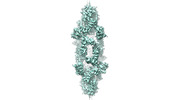+Search query
-Structure paper
| Title | Biparatopic nanobodies targeting the receptor binding domain efficiently neutralize SARS-CoV-2. |
|---|---|
| Journal, issue, pages | iScience, Vol. 25, Issue 11, Page 105259, Year 2022 |
| Publish date | Nov 18, 2022 |
 Authors Authors | Phillip Pymm / Samuel J Redmond / Olan Dolezal / Francesca Mordant / Ester Lopez / James P Cooney / Kathryn C Davidson / Ebene R Haycroft / Chee Wah Tan / Rebecca Seneviratna / Samantha L Grimley / Damian F J Purcell / Stephen J Kent / Adam K Wheatley / Lin-Fa Wang / Andrew Leis / Alisa Glukhova / Marc Pellegrini / Amy W Chung / Kanta Subbarao / Adam P Uldrich / Wai-Hong Tham / Dale I Godfrey / Nicholas A Gherardin /   |
| PubMed Abstract | The development of therapeutics to prevent or treat COVID-19 remains an area of intense focus. Protein biologics, including monoclonal antibodies and nanobodies that neutralize virus, have potential ...The development of therapeutics to prevent or treat COVID-19 remains an area of intense focus. Protein biologics, including monoclonal antibodies and nanobodies that neutralize virus, have potential for the treatment of active disease. Here, we have used yeast display of a synthetic nanobody library to isolate nanobodies that bind the receptor-binding domain (RBD) of SARS-CoV-2 and neutralize the virus. We show that combining two clones with distinct binding epitopes within the RBD into a single protein construct to generate biparatopic reagents dramatically enhances their neutralizing capacity. Furthermore, the biparatopic nanobodies exhibit enhanced control over clinically relevant RBD variants that escaped recognition by the individual nanobodies. Structural analysis of biparatopic binding to spike (S) protein revealed a unique binding mode whereby the two nanobody paratopes bridge RBDs encoded by distinct S trimers. Accordingly, biparatopic nanobodies offer a way to rapidly generate powerful viral neutralizers with enhanced ability to control viral escape mutants. |
 External links External links |  iScience / iScience /  PubMed:36213007 / PubMed:36213007 /  PubMed Central PubMed Central |
| Methods | EM (single particle) |
| Resolution | 3.89 - 4.19 Å |
| Structure data |  EMDB-28189: SARS-CoV-2 Spike in complex with biparatopic nanobody BP10  EMDB-28190: SARS-CoV-2 RBD in complex with biparatopic nanobody BP10 local refinement |
| Source |
|
 Movie
Movie Controller
Controller Structure viewers
Structure viewers About Yorodumi Papers
About Yorodumi Papers




 Severe acute respiratory syndrome coronavirus 2
Severe acute respiratory syndrome coronavirus 2
